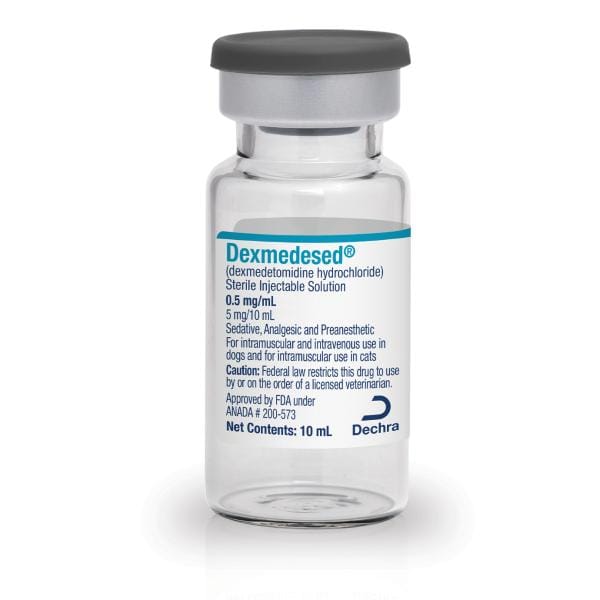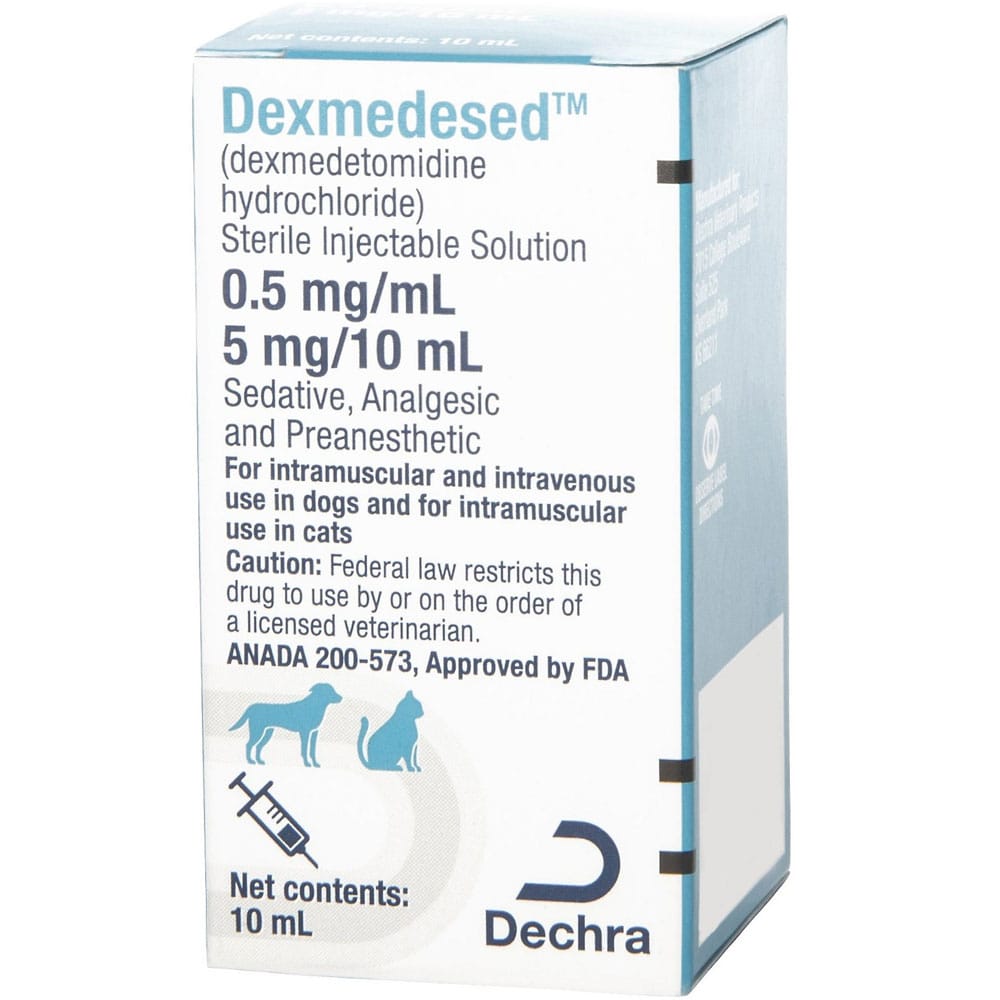Please note: a valid prescription is required for all prescription medication.
Dexmedesed® Vial for Canine and Feline Sedation
Sitewide Super Sale - Get 15% off when you buy 3 or more of the same product using the code LESS15 at checkout.
Applies to all products originating from Canada. Maximum quantity limited to a 90-day supply per order.
$201.99
You save


Dexmedesed is an injectable alpha-2 adrenergic agonist used for procedural sedation and analgesia in dogs and cats. This description explains what it is, how it is used, and key safety points for veterinary care. You can place an order with US shipping from Canada and compare options without insurance.
What Dexmedesed Is and How It Works
Dexmedesed® contains dexmedetomidine hydrochloride, a sedative and analgesic for veterinary use. It activates central alpha-2 receptors, which reduces norepinephrine release and leads to dose-dependent sedation, muscle relaxation, and modest pain control. The effect can be reversed with atipamezole when clinically indicated.
As a Sedation agent, the treatment may be used alone or with other anesthetics during minor procedures, imaging, and pre-anesthetic protocols. When used as a dexmedesed vial for injection, clinicians titrate by weight and clinical response under monitoring. CanadianInsulin.com is a prescription referral platform. We verify prescriptions with your prescriber when required, and licensed Canadian pharmacies dispense your order.
Who It’s For
This medicine is indicated for sedation and analgesia in healthy dogs and cats when supervised by a veterinarian. It may be selected for procedures that require controllable sedation and smooth recovery with a reversal option. Animals with significant cardiovascular disease, severe systemic illness, shock, or known hypersensitivity to alpha-2 agonists should generally avoid it unless a clinician determines benefits outweigh risks.
For situational noise sensitivity or short-term calming needs, other options may be considered. For example, Sileo Gel is approved for canine noise aversion and may be used in different contexts than procedural sedation.
Dosage and Usage
Dosing is individualized by species, weight, and intended depth of sedation. Clinicians commonly use intramuscular or intravenous routes with careful cardiovascular and respiratory monitoring. Use the smallest effective dose, especially when combining with opioids or induction agents.
When preparing a dexmedesed 5 mL vial for administration, use sterile syringes, verify the concentration, and follow the clinic’s aseptic technique. Allow adequate time for onset before escalating dose, and reassess reflexes and vital signs after any adjustment. Reversal with atipamezole should follow label guidance, typically given intramuscularly in dogs and with species-specific considerations in cats.
If incorporating a tranquilizer into the protocol, some clinics also use acepromazine in select cases; discuss suitability before combining. You can review a commonly used phenothiazine tranquilizer here: Acevet 25 Injectable.
Strengths and Forms
This product is supplied as a sterile solution for injection. Availability may vary by clinic and pharmacy.
- Concentration: dexmedesed 100 mcg/mL vial (dexmedetomidine HCl)
- Volumes: 5 mL and 10 mL multi-dose vials where supplied
- Presentation: clear solution intended for intramuscular or intravenous use
Always confirm the concentration on the label before calculating the dose. Multi-dose presentations should be punctured with a new sterile needle each time to reduce contamination risk.
Missed Dose and Timing
This medicine is administered by or under the direction of a veterinarian, often within a clinical setting. If a planned pre-procedural dose is delayed, the team typically reassesses sedation targets and timing rather than repeating unsupervised. Do not administer extra doses outside the planned protocol unless directed by a clinician.
Storage and Travel Basics
Store vials at controlled room temperature per label instructions and protect from light. Keep in the original carton when possible, with the cap in place to prevent contamination. Do not use if the solution is discolored, contains particulate matter, or if sterility is compromised.
Keep medications out of reach of children and animals. If you travel with the vial, carry the prescription, a copy of the veterinarian’s instructions, and pack syringes in a puncture-proof container. Place medications in your hand luggage where temperature is more stable, and follow local regulations for transporting sharps. For general supply planning and related needs, browse our Pet Medications category.
Pen Handling and Sharps Disposal
This product is a vial-based injection; it is not supplied as a pen. Use sterile single-use needles and syringes. Do not reuse needles. After administration, place used needles and syringes in an approved sharps container. Follow municipal or clinic guidance for safe disposal. Never discard sharps in household waste.
Benefits
Alpha-2 agonists may provide predictable, titratable sedation with muscle relaxation. When clinically appropriate, reversal with atipamezole can shorten recovery after procedures. The agent can reduce anesthetic requirements when used in balanced protocols, which may aid hemodynamic control under supervision.
Some clinics also consider alternative tranquilizers for pre-visit sedation plans when suitable. See options like Atravet for context discussions with a clinician.
Side Effects and Safety
- Common: drowsiness, pale mucous membranes, decreased heart rate
- Possible: vomiting (dogs), transient blood pressure changes, reduced respiratory rate
- Post-reversal: brief excitement or panting in some patients
Serious reactions can include profound bradycardia, hypotension or hypertension, arrhythmias, and respiratory depression. Animals with heart disease, severe hepatic impairment, or shock may face higher risk. When used with other sedatives, opioids, or anesthetics, effects may be additive. Close monitoring of cardiovascular and respiratory parameters is recommended. Contact a veterinarian immediately if severe adverse effects occur.
Drug Interactions and Cautions
Use caution when combining with opioids, propofol, inhalant anesthetics, or other central nervous system depressants due to additive effects. Anticholinergics, vasopressors, and reversal agents should be used according to clinical judgment and label guidance. Avoid use in dehydrated, debilitated, or hypovolemic animals unless the clinician determines the benefit outweighs the risk.
Food, water, and environmental stress can influence response to sedation. Withhold food per pre-anesthetic instructions when indicated, and ensure a calm environment before and after administration.
What to Expect Over Time
Sedation depth and duration can vary by dose, route, species, and co-administered agents. The effect is often characterized by calm behavior, reduced responsiveness, and steady muscle relaxation. Recovery quality may improve when environmental stimulation is minimized and reversal is timed appropriately.
Clinics may develop standardized protocols for common procedures, with careful monitoring to guide adjustments. Clear documentation of doses, routes, and observed responses can help refine future sedation plans.
Compare With Alternatives
In some cases, a branded alpha-2 agonist may be selected for similar indications. Review Dexdomitor Vial with your veterinarian when considering brand-specific protocols. For induction or deeper anesthesia needs, another option is Propofol, used within a balanced anesthetic plan under monitoring.
Pricing and Access
Transparent information helps clinics and pet owners plan care. You can review the dexmedesed vial price online and compare package sizes that fit your protocol. We offer Canadian pricing with reliable ordering and US delivery from Canada.
Looking for seasonal deals or limited offers? See our current notices on the Promotions page. When you proceed to checkout, you can use encrypted checkout for added security.
Availability and Substitutions
Stock levels can change based on manufacturer supply and demand. If there is a delay in dexmedesed vial availability, a prescriber may recommend a suitable alternative or adjust the plan. Another alpha-2 option to discuss is Dexvetidine Vial, subject to clinical judgment and local availability.
Patient Suitability and Cost-Saving Tips
This medicine may suit healthy adult dogs and cats undergoing minor procedures or pre-anesthetic sedation where cardiovascular status allows. Animals with advanced cardiac disease, severe systemic illness, or known hypersensitivity may need alternative plans.
For cost control, consider consolidating orders for multi-procedure schedules when practical, and coordinate refills ahead of planned surgeries. Clinics may reduce administrative time by keeping standardized protocols and labeling logs for consistent dosing and inventory tracking. You can also compare unit pricing between vial sizes to align with expected utilization and minimize waste.
Questions to Ask Your Clinician
- Indication and goal: what procedure and depth of sedation?
- Dose plan: route, titration steps, and monitoring setup
- Reversal: when and how to use atipamezole
- Combinations: opioids, tranquilizers, or induction agents
- Risks: cardiac, respiratory, and recovery considerations
- Discharge: expected observation time and home care
Authoritative Sources
For label and safety information, see the manufacturer’s materials and regulatory databases. The following resources provide official product or class information:
- FDA Center for Veterinary Medicine information on approved animal drugs
- Health Canada Drug Product Database for product listings
- Zoetis corporate site for veterinary product information
Ready to proceed? You can place your request online with prompt, express shipping and temperature-controlled handling when required.
Medical disclaimer: This content is for informational purposes only and is not a substitute for professional medical advice.
Express Shipping - from $25.00
Shipping with this method takes 3-5 days
Prices:
- Dry-Packed Products $25.00
- Cold-Packed Products $35.00
Standard Shipping - $15.00
Shipping with this method takes 5-10 days
Prices:
- Dry-Packed Products $15.00
- Not available for Cold-Packed products
What species is Dexmedesed used for?
Veterinarians use this medicine for sedation and analgesia in dogs and cats. Suitability depends on health status, procedure type, and monitoring capabilities.
How quickly does sedation occur?
Onset varies by dose, route, and co-administered agents. Clinicians monitor response and adjust the plan as needed rather than relying on set timelines.
Can the effects be reversed?
Yes. Clinicians may administer atipamezole to reverse alpha-2 agonist effects when appropriate, following label guidance and species-specific considerations.
Is home administration recommended?
This medicine is typically administered by veterinary professionals. Any use outside a clinic should occur only with prescriber direction and a documented plan.
What if my clinic misses a planned dose time?
The team will reassess sedation needs and timing. Do not repeat or add doses without clinician direction, as cardiovascular effects can intensify unpredictably.
How should I store the vial?
Store at controlled room temperature, protect from light, and keep in the original carton. Keep out of reach of children and animals. Do not use if discolored or contaminated.
Are there interactions with other anesthetics?
Yes. Additive sedation can occur with opioids, propofol, inhalants, and other CNS depressants. The veterinarian will adjust the plan and monitor closely.
Rewards Program
Earn points on birthdays, product orders, reviews, friend referrals, and more! Enjoy your medication at unparalleled discounts while reaping rewards for every step you take with us.
You can read more about rewards here.
POINT VALUE
How to earn points
- 1Create an account and start earning.
- 2Earn points every time you shop or perform certain actions.
- 3Redeem points for exclusive discounts.
You Might Also Like
Related Articles
Zepbound storage: Keep It Safe With Clear Temperature Rules
This guide explains Zepbound storage so your medication stays effective. You will learn temperature limits, how long doses can stay unrefrigerated, travel practices, and what to do if a pen…
Zepbound and Fatigue: Practical Tips to Ease Tiredness Safely
Feeling drained after starting tirzepatide can be unsettling. Many users describe a mix of low energy, mild aches, and disrupted sleep early on. If you are navigating Zepbound and fatigue,…
Mounjaro Heart Benefits Beyond Weight Loss: Evidence-Based Guide
Interest has grown around Mounjaro heart benefits as clinicians evaluate tirzepatide’s broader impact beyond glucose control and weight. Patients want clear, cautious guidance. This overview explains what current data suggests,…
Ozempic Rebound: A Practical Guide to Prevent Weight Regain
Many people stop GLP-1 therapy and wonder what comes next. Appetite changes, routine shifts, and metabolism can collide. A clear plan helps you keep progress steady and predictable, not reactive.…


